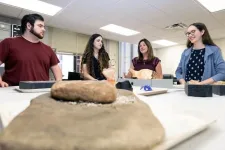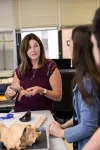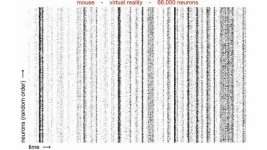(Press-News.org) Dr. Katie Custer Bojakowski, an instructional assistant professor in the Department of Anthropology at Texas A&M University and the director and curator of its Anthropology Research Collections (ARC), has been awarded a Preservation Assistance Grant from the National Endowment for the Humanities (NEH).
The NEH’s Preservation Assistance Grants program helps organizations protect their collections of historical and cultural items, making sure they remain available for students, scholars and the public. These grants help address risks to these collections, keeping valuable artifacts safe for future generations.
Texas A&M’s ARC has been dedicated to this cause since 1971, working to preserve artifacts from faculty and student fieldwork along with those acquired via public donation. However, after accumulating more than 120,000 items representing 10,000 years of Texas history and beyond, the ARC's ability to grow and modernize its collections is currently limited.
Bojakowski says the NEH grant will help protect and improve access to the anthropological and archaeological materials housed within the ARC while also giving Texas A&M graduate students additional learning opportunities. In addition, the funding will enable the ARC to move toward becoming a state-certified repository and digitizing its materials for broader access.
"While the ARC holds state of Texas-owned artifacts in trust, we are unable to accept new material due to our lack of certification,” explained Bojakowski, who earned her Ph.D. in anthropology from Texas A&M in 2011. “Our digitization goal is hindered by the absence of a digital preservation policy. Becoming a state-certified repository and digitizing our collection would improve our ability to serve the research community and public by expanding access. It will also generate new research topics for students."
Anthropology Ph.D. candidate and former ARC assistant curator Emma Newman '23, ARC assistant collections manager Lauren Jones and anthropology graduate student Kim Breyfogle '23 helped write the grant proposal and will join a museum specialist for a site visit to review the collection’s needs and get advice on how to meet national preservation standards.
The NEH grant ensures the ARC’s ability to enhance its digital preservation efforts, creating high-quality images that will allow researchers to study artifacts without handling them. Such modernization will make the ARC’s resources more widely accessible. Those resources include stone tools, animal remains and other organic materials that have been integral to significant research projects. The ARC’s collections have supported graduate theses and faculty research at Texas A&M and beyond, with many scholars relying on the unique resources to further their work. Bojakowski’s digitization efforts will enable remote research, encouraging broader collaboration and scholarship.
A key aspect of the NEH grant is its focus on supporting small and mid-sized institutions, which often face challenges in maintaining their collections. The grant will not only help the ARC safeguard its own materials but also set an example for other institutions on how to manage and digitize archaeological collections.
Beyond research, ARC plays an essential role in education and community outreach. Its collections are used in classrooms, public events and exhibitions to teach Texas history and archaeology. Bojakowski’s project will ensure this legacy is preserved and make these important artifacts available to future generations.
“The ARC is a valuable resource for both researchers and students, and this NEH grant will allow us to continue serving as a central hub of knowledge for Texas and beyond,” Bojakowski added.
Bojakowski’s efforts to preserve and expand the ARC are part of a larger movement to enhance educational opportunities within Texas A&M Anthropology. Similar initiatives, such as the Lynn Hagan ’77 Endowment for Museum Studies, are contributing to this goal by providing resources for students to gain hands-on experience in museum work and research. The Hagan endowment, valued at $25,000 with a planned $1 million gift, supports internships, field trips and projects, further strengthening the department’s commitment to developing future anthropologists and museum professionals. In combination, these programs will give Texas A&M students a well-rounded education based on both research and hands-on experience.
Learn more about the ARC or Bojakowski's teaching, research and service at Texas A&M.
By Grant Hawkins, Texas A&M University College of Arts and Sciences
###
END
Professor awarded NEH grant to advance anthropology research collections at Texas A&M
2024-10-24
ELSE PRESS RELEASES FROM THIS DATE:
New tool helps scientists spot patterns in mountains of data
2024-10-24
Neuroscientists have learned a lot – like which neurons and circuits are associated with different behaviors – by recording the activity of small sets of neurons.
But what happens when you record thousands of neurons at one time? Or when you want to figure out the role of neurons when there isn’t an obvious external catalyst or you’re not sure what you’re even looking for?
That’s where Rastermap comes in.
The new visualization tool developed by the Stringer and Pachitariu labs at HHMI's Janelia Research Campus helps ...
Glomerular filtration rate changes following UTI in children with vesicoureteral reflux
2024-10-24
About The Study: This cohort study uses data from the Children With Vesicoureteral Reflux trial to assess estimated glomerular filtration rate (eGFR) changes in participants with vs without recurrent urinary tract infections.
Corresponding Author: To contact the corresponding author, David S. Hains, MD, MBA, email dhains@iu.edu.
To access the embargoed study: Visit our For The Media website at this link https://media.jamanetwork.com/
(doi:10.1001/jamapediatrics.2024.4546)
Editor’s Note: Please see the article for additional information, including other authors, author contributions ...
Dandelion-shaped supernova and zombie star
2024-10-24
In 1181, a new star shone near the Cassiopeia constellation for six months before disappearing. This event, recorded as a “guest star” by Chinese and Japanese observers almost a millennium ago, has puzzled astronomers for centuries. It is one of a few supernovae to be documented before the invention of telescopes. In addition, it remained an “orphan” the longest, meaning that none of the celestial objects visible today could be assigned to it. Now known as the supernova SN 1181, its remnant has only been traced in 2021 to the nebula ...
Experts call for clear and concise regulation of exosome-based treatments
2024-10-24
Clinics that offer exosome therapies claim they have the ability to repair and regenerate tissues and treat inflammatory and other immune-related conditions in a noninvasive way. Now, a team of bioethicists and legal scholars from Japan is sounding the alarm on the urgent need for stronger regulations surrounding these unproven interventions. Their letter appears October 24 in the journal Stem Cell Reports.
“Administering these treatments to patients without scientific evidence or a clear ...
Zebrahub: New atlas tracks zebrafish development like never before
2024-10-24
When early cartographers undertook perilous expeditions to map unknown corners of the world with sextants, compasses, and hand-drawn diagrams, it’s unlikely they imagined that someday anyone with an internet connection would have access to a seamless view of the entire planet from the comfort of their own home. Today, pioneering scientists are working to create a similar experience for a much tinier, but no less important domain: developing embryos. The goal is to track and map the behavior of each and every cell working together to create an adult lifeform, and present that map in a clickable, ...
Unnoticeable electric currents could reduce skin infections
2024-10-24
Using a few zaps of electricity to the skin, researchers can stop bacterial infections without using any drugs. For the first time, researchers designed a skin patch that uses imperceptible electric currents to control microbes. The results appear October 24 in the Cell Press journal Device.
“This opens up exciting possibilities for drug-free treatments, especially for skin infections and wound healing, where antibiotic-resistant bacteria pose a serious challenge,” says University of Chicago’s Bozhi Tian, one of the paper’s ...
Expanded newborn screening using genome sequencing for early actionable conditions
2024-10-24
About The Study: These interim findings demonstrate the feasibility of targeted interpretation of a predefined set of genes from genome sequencing in a population of different racial and ethnic groups. DNA sequencing offers an additional method to improve screening for conditions already included in newborn screening and to add those that cannot be readily screened because there is no biomarker currently detectable in dried blood spots. Additional studies are required to understand if these findings are generalizable to populations of different racial and ethnic groups and ...
In pioneering study, gene technology outperforms standard newborn screening tests
2024-10-24
Early results from a study of newborn screening methods show that DNA analysis picks up many more preventable or treatable serious health conditions than standard newborn screening and is favored by most parents who are offered the option.
The study—called GUARDIAN—is one of the first large-scale studies in the world to use genome sequencing as a method for newborn screening and is the first to publish preliminary results.
“The results show us that genome sequencing can radically improve children’s medical care,” says Joshua Milner, professor of Pediatrics, director of Allergy/Immunology and Rheumatology ...
Racial disparities in receipt of guideline-concordant care in older adults with early breast cancer
2024-10-24
About The Study: In this cohort study, non-Hispanic Black race was associated with increased odds of not receiving guideline-concordant care (GCC) and less timely treatment initiation. Non-Hispanic Black race was associated with increased all-cause mortality, which was reduced after adjusting for GCC and clinical and sociodemographic factors. These findings suggest that optimizing timely receipt of GCC may represent a modifiable pathway to improving inferior survival outcomes among older non-Hispanic Black ...
Fentanyl, heroin, methamphetamine, and cocaine analyte concentrations in urine drug testing specimens
2024-10-24
About The Study: This cross-sectional study found that absolute concentrations of fentanyl, methamphetamine, and cocaine in urine specimens increased from 2013 to 2023, with a decrease in heroin concentration during that period. The findings suggest that exposure to these substances, as well as the illicit drug supply, has fundamentally changed in many parts of the U.S., highlighting the need to reinforce surveillance initiatives and accelerate efforts to treat individuals with illicitly manufactured fentanyl and/or stimulant exposure.
Corresponding Author: To ...




